Halimeda
Halimeda is a genus of green macroalgae. The algal body (thallus) is composed of calcified green segments. Calcium carbonate is deposited in its tissues, making it inedible to most herbivores. However one species, Halimeda tuna, was described as pleasant to eat with oil, vinegar, and salt.[3][4]
| Halimeda | |
|---|---|
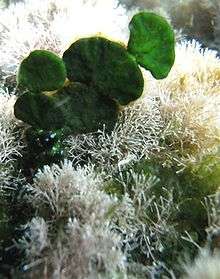 | |
| Halimeda tuna | |
| Scientific classification | |
| Phylum: | Chlorophyta |
| Class: | Ulvophyceae |
| Order: | Bryopsidales |
| Family: | Halimedaceae |
| Genus: | Halimeda J.V.Lamouroux, 1812 |
| Type species | |
| Halimeda tuna (J. Ellis & Solander) J.V. Lamouroux, 1816 | |
| Species[2] | |
|
See text | |
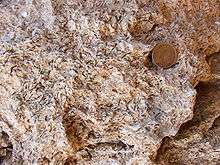
As in other members of the order Bryopsidales, individual organisms are made up of single multi-nucleate cells. Whole meadows may consist of a single individual alga connected by fine threads running through the substrate.[5]
Halimeda is responsible for distinctive circular deposits in various parts of the Great Barrier Reef on the north-east coast of Queensland, Australia. Halimeda beds form in the western or lee side of outer shield reefs where flow of nutrient-rich water from the open sea allows them to flourish, and are the most extensive, actively accumulating Halimeda beds in the world.
The genus is one of the best studied examples of cryptic species pairs due to morphological convergence within the marine macroalgae. [6] [7] [8]
Some species grow so vigorously in tropical lagoons that the sediment is composed solely of the remains of their tissues, forming a calcareous "Halimeda sand". In fact some tropical reef systems, such as atolls, consist largely of Halimeda sand accumulated over the aeons.[9]
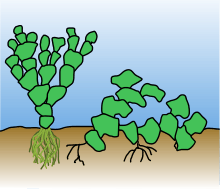
Species
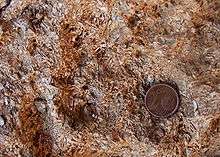
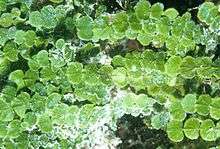
- H. bikinensis
- H. borneensis
- H. cereidesmis
- H. copiosa
- H. cryptica
- H. cuneata
- H. cylindracea
- H. discoidea
- H. distorta
- H. favulosa
- H. fragilis
- H. gigas
- H. goreauii
- H. gracilis
- H. heteromorpha
- H. howensis
- H. hummii
- H. incrassata
- H. kanaloana
- H. lacrimosa
- H. lacunalis
- H. macroloba
- H. macrophysa
- H. magnidisca
- H. melanesica
- H. micronesica
- H. minima
- H. monile
- H. opuntia
- H. pumila
- H. pygmaea
- H. renschii
- H. scabra
- H. simulans
- H. stuposa
- H. taenicola
- H. tuna
- H. velasquezii
References
- Hillis, L.W. (2001). "The calcareous reef alga Halimeda (Chlorophyta, Byropsidales): a cretaceous genus that diversified in the cenozoic". Palaeogeography, Palaeoclimatology, Palaeoecology. 166 (1–2): 89–100. doi:10.1016/s0031-0182(00)00203-0. ISSN 0031-0182.
- Guiry, M.D.; Guiry, G.M. (2007). "Genus: Halimeda taxonomy browser". AlgaeBase version 4.2 World-wide electronic publication, National University of Ireland, Galway. Retrieved 2007-09-24.
- Bauhin, Jean; Cherler, Johann Heinrich (1651). "Liber XXXIX". Historia plantarum [...] Tomus III (PDF) (in Latin). Ebroduni. p. 803. OCLC 495081149. Retrieved 15 February 2018.
Nà Theophraftus (1. cap. hist. c. 12) scribit circa Opuntem herbulam effe quandam, quae ex foliis radicem mittat, ac cum suauitate mandi possit. Plinius verò ipsum sequutus (21.cap.17) circa Opuntem, inquit, Opuntia est herba, etiam homini-dulcis: mirúmque è folio ejus radicem sièri, ac sic eam nasci. Et certè credibile est hanc plantam recentem cum aceto, sale, & oleo, vel etiam sine sale, non minùs suauiter edi posse quàm Portulacae marinae & sìmilium folia.
- Hills-Colinvaux, Llewellya (27 May 1980). Baxter, J.H.S.; Russell, Frederick S.; Yonge, Maurice (eds.). Ecology and Taxonomy of Halimeda: Primary Producer of Coral Reefs (PDF). Advances in Marine Biology. 17. Academic Press. pp. 17–18. ISBN 9780080579405. OCLC 476214112. Retrieved 15 February 2018.
- The Cell Biology of the Bryopsidales
- Kooistra W.H.C.F., Coppejans E.G.G. & Payri C. (2002). Molecular systematics, historical ecology, and phylogeography of Halimeda. (Bryopsidales) Molecular Phylogenetics and Evolution 24: 121–138
- Verbruggen H., De Clerck O., Kooistra W.H.C.F. & Coppejans E. (2005). Molecular and morphometric data pinpoint species boundaries in Halimeda section Rhipsalis (Bryopsidales, Chlorophyta). Journal of Phycology 41: 606-621
- Verbruggen H., De Clerck O., Schils T., Kooistra W.H.C.F. & Coppejans E. (2005). Evolution and phylogeography of Halimeda section Halimeda. Molecular Phylogenetics and Evolution 37: 789-803
- Hoek, Christiaan; Mann, David; Jahns, H.M. (1995). Algae: An Introduction to Phycology. Cambridge University Press. p. 434. ISBN 978-0-521-31687-3.
External links
- "Deepwater seagrass and Halimeda: lost lawns of the outer shelf",
- Australian Institute of Marine Science, retrieved 10 November 2006
- "Other species of conservation concern",
- Great Barrier Reef Marine Park Authority, retrieved 10 November 2006
- ReefCorner - Halimeda Algae Database Entry